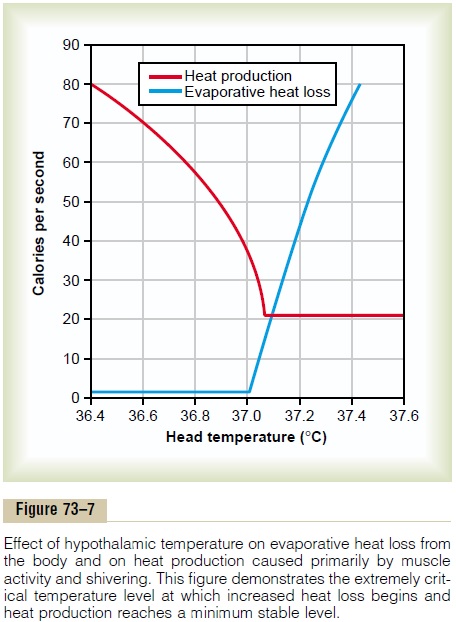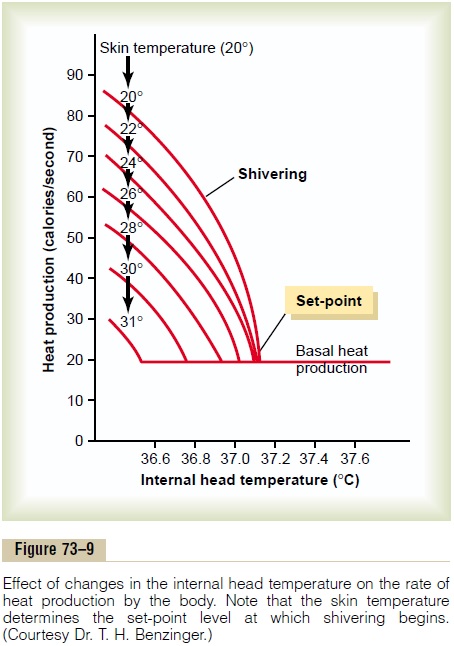Chapter: Medical Physiology: Body Temperature, Temperature Regulation, and Fever
Concept of a “Set-Point” for Temperature Control
Concept of a “Set-Point” for Temperature Control
In the example of Figure 73–7, it is clear that at a crit-ical body core temperature of about 37.1°C (98.8∞F), drastic changes occur in the rates of both heat loss and heat production. At temperatures above this level, the rate of heat loss is greater than that of heat produc-tion, so the body temperature falls and approaches the 37.1°C level. At temperatures below this level, the rate of heat production is greater than that of heat loss, so the body temperature rises and again approaches the 37.1°C level. This crucial temperature level is called the “set-point” of the temperature control mechanism. That is, all the temperature control mechanisms con-tinually attempt to bring the body temperature back to this set-point level.

Feedback Gain for Body Temperature Control. Let us recall the discussion of feedback gain of control systems. Feedback gain is a measure of the effectiveness of a control system. In the case of body temperature control, it is important for the internal core temperature to change as little as possible, even though the environmental temperature might change greatly from day to day or even hour to hour. The feed-back gain of the temperature control system is equalto the ratio of the change in environmental tempera-ture to the change in body core temperature minus 1.0. Experiments have shown that the body temperature of humans changes about 1°C for each 25° to 30°C change in environmental temperature. Therefore, the feedback gain of the total mechanism for body temperature control averages about 27 (28/1.0 – 1.0 = 27), which is an extremely high gain for a biological control system (the baroreceptor arterial pressure control system, for instance, has a feedback gain of less than 2).
Skin Temperature Can Slightly Alter the Set-Point for Core Temperature Control
The critical temperature set-point in the hypothalamus above which sweating begins and below which shiver-ing begins is determined mainly by the degree of activ-ity of the heat temperature receptors in the anterior hypothalamic-preoptic area. However, temperature signals from the peripheral areas of the body, espe-cially from the skin and certain deep body tissues (spinal cord and abdominal viscera), also contribute slightly to body temperature regulation. But how do they contribute? The answer is that they alter the set-point of the hypothalamic temperature control center. This effect is shown in Figures 73–8 and 73–9.

Figure 73–8 demonstrates the effect of different skin temperatures on the set-point for sweating, showing that the set-point increases as the skin temperature decreases. Thus, for the person represented in this figure, the hypothalamic set-point increased from 36.7°C when the skin temperature was higher than 33°C to a set-point of 37.4°C when the skin tempera-ture had fallen to 29°C. Therefore, when the skin

temperature was high, sweating began at a lower hypothalamic temperature than when the skin tem-perature was low. One can readily understand the value of such a system, because it is important that sweating be inhibited when the skin temperature is low; otherwise, the combined effect of low skin temperature and sweating could cause far too much loss of body heat.
A similar effect occurs in shivering, as shown in Figure 73–9. That is, when the skin becomes cold, it drives the hypothalamic centers to the shivering threshold even when the hypothalamic temperature itself is still on the hot side of normal. Here again, one can understand the value of the control system, because a cold skin temperature would soon lead to a deeply depressed body temperature unless heat pro-duction were increased. Thus, a cold skin temperature actually “anticipates” a fall in internal body tempera-ture and prevents this.
Related Topics